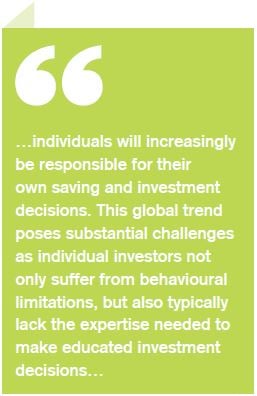
Retirement Goal-Based Investing
Industry Analysis
Retirement Goal-Based Investing
The need for new retirement solutions
With the need to supplement retirement savings via voluntary contributions, individuals will increasingly be responsible for their own saving and investment decisions. This global trend poses substantial challenges as individual investors not only suffer from behavioural limitations, but also typically lack the expertise needed to make educated investment decisions.
In response to these concerns, a number of new investment products have been proposed over the past few years by asset management companies. There are reasons to believe, however, that these products known as target date funds fall short of providing satisfactory solutions to the problems faced by individuals when approaching investment saving decisions.
First of all, target date funds offer a sole focus on the investment horizon without any protection of investors’ minimum retirement needs. In particular, these products are not engineered to deliver replacement income in retirement, and do not achieve a proper hedging of the main risks related to the retirement investing decisions, namely investment risk, interest rate risk, inflation risk and longevity risk. Another important restriction is that most existing target-date funds do not allow for revisions of the asset allocation as a function of changes in market conditions. This is entirely inconsistent with academic prescriptions, and also common sense, which both suggest that the optimal strategy should also display an element of dependence on the state of the economy.
Towards improved forms of retirement investment solutions
Currently available investment options hardly provide a satisfying answer to the retirement investment challenge, and most individuals are left with an unsatisfying choice between, on the one hand, safe strategies with very limited upside potential, which will not allow them to generate the kind of target replacement income they need in retirement and, on the other hand, risky strategies offering no security with respect to minimum levels of replacement income.
 This stands in contrast with a well-designed retirement solution that would allow individual investors to secure the kind of replacement income in retirement needed to meet their essential consumption goals, while generating a relatively high probability for them to achieve their aspirational consumption goals, with possible additional goals including healthcare, old age care and/or bequest.
This stands in contrast with a well-designed retirement solution that would allow individual investors to secure the kind of replacement income in retirement needed to meet their essential consumption goals, while generating a relatively high probability for them to achieve their aspirational consumption goals, with possible additional goals including healthcare, old age care and/or bequest.
This recognition is leading to a new investment paradigm, which has been labelled goal-based investing (GBI) in individual money management – see Deguest et al. (2015) for a formal analysis. Within this paradigm, investors' problems can be fully characterised in terms of their lifetime meaningful goals, just as liability-driven investing (LDI) has become the relevant paradigm in institutional money management, where investors' problems are broadly summarised in terms of their liabilities.
The GBI retirement solutions are deeply rooted in simple and profound academic principles and involve:
- A dedicated and safe goal-hedging portfolio (GHP) that replicates risk factor exposures in investors’ replacement income goals (dynamic replicating portfolio for inflation-linked deferred annuities);
- A common well-rewarded risky performance-seeking portfolio (PSP) that efficiently harvests risk premia in equity markets;
- A dynamic allocation to PSP versus GHP portfolios that (i) reacts to changes in market conditions and (ii) secures minimum replacement income levels while generating a high probability of achieving target replacement income levels.
As such, the framework builds upon a comprehensive and holistic integration of the three forms of risk management, namely hedging, diversification and insurance. This is in contrast to existing products or approaches used in institutional or individual money management, which are only based on selected risk management principles.
While each of these sources of value added is already used to some extent in different contexts, full integration of all these elements within a comprehensive disciplined investment management framework is required for the design of meaningful investment solutions.
EDHEC-Princeton retirement bond and retirement goal index series
 The most natural way to frame an investor’s retirement goal is in terms of how much lifetime guaranteed inflation-linked replacement income they will be able to afford to purchase upon retirement. Given that the biggest risk in retirement is the risk of outliving one’s retirement assets, securing inflation-linked replacement income within the decumulation period can be achieved with inflation-linked annuities, which are the true risk-free assets for individuals preparing for retirement.
The most natural way to frame an investor’s retirement goal is in terms of how much lifetime guaranteed inflation-linked replacement income they will be able to afford to purchase upon retirement. Given that the biggest risk in retirement is the risk of outliving one’s retirement assets, securing inflation-linked replacement income within the decumulation period can be achieved with inflation-linked annuities, which are the true risk-free assets for individuals preparing for retirement.
Annuity products, however, are cost inefficient, irreversible, and do not contribute to bequest objectives. These elements undoubtedly explain the low demand for annuities (i.e. the “annuity puzzle”, when annuitisation is not incentivised or mandatory). A good case can actually be made that annuitisation is a decision that is best taken close to retirement, if ever.
This point was made explicitly in Merton (2013): “Most people would not want to buy an actual life annuity during the accumulation period prior to retirement (…). If the individual buys an annuity on his life, it is reversible only at a high cost, which means if he dies two years from now, he loses everything. If his life circumstances change - get married, get divorced, start a second family - the lack of flexibility can be costly. The right time for him to determine the detail of post-retirement investment choices (…) is as close to retirement as possible when he has the most information about his health, his responsibilities, his opportunities, and his preferences.”
In the UK, the 2015 Pension Schemes Act, which has nullified the compulsory annuity purchase, creates a tremendous opportunity for asset managers to launch meaningful forms of retirement solutions. A key ingredient in these retirement solutions is a novel form of fixed-income portfolio, where the key focus should be on generating inflation-linked or cost-of-living-adjusted replacement income for a period of time roughly corresponding to the average life expectancy in retirement (say between 20 and 25 years after the retirement date). In parallel, late-life annuities can be purchased in decumulation to obtain protection against tail longevity risk.
 In the context of these aforementioned changes in the retirement landscape, EDHEC-Risk Institute has teamed up with Princeton University’s Operations Research and Financial Engineering (ORFE) department to launch a retirement bond index series. This initiative, supported by Merrill Lynch Wealth Management (MLWM) in the context of the “Risk Allocation Framework for Goal-Driven Investing Strategies” research chair at EDHEC-Risk Institute. More specifically, the so-called retirement goal bond index is designed to dynamically hedge interest rate risks and realised or expected inflation risks, thereby forming a dynamic proxy for a forward inflation-linked or cost-of-living adjusted bond ladder. The introduction of this retirement goal index series is consistent with the prescription of asset pricing theory, which has shown that T-Bills investment is a low volatility strategy from an absolute return perspective, but extremely risky for use in a retirement context since it leads to a highly volatile level of purchasing power expressed in terms of inflation-linked replacement income. In parallel, dynamic asset allocation goal-based retirement indices (which involve the use of retirement bond indices and equity indices) can also be proposed to allow investors to secure a minimum level of replacement income in retirement while generating attractive probabilities of achieving a target level of replacement income.
In the context of these aforementioned changes in the retirement landscape, EDHEC-Risk Institute has teamed up with Princeton University’s Operations Research and Financial Engineering (ORFE) department to launch a retirement bond index series. This initiative, supported by Merrill Lynch Wealth Management (MLWM) in the context of the “Risk Allocation Framework for Goal-Driven Investing Strategies” research chair at EDHEC-Risk Institute. More specifically, the so-called retirement goal bond index is designed to dynamically hedge interest rate risks and realised or expected inflation risks, thereby forming a dynamic proxy for a forward inflation-linked or cost-of-living adjusted bond ladder. The introduction of this retirement goal index series is consistent with the prescription of asset pricing theory, which has shown that T-Bills investment is a low volatility strategy from an absolute return perspective, but extremely risky for use in a retirement context since it leads to a highly volatile level of purchasing power expressed in terms of inflation-linked replacement income. In parallel, dynamic asset allocation goal-based retirement indices (which involve the use of retirement bond indices and equity indices) can also be proposed to allow investors to secure a minimum level of replacement income in retirement while generating attractive probabilities of achieving a target level of replacement income.
While these dynamic retirement goal-based indices are not investable and are meant to be used for education purposes only, our hope is that they will help inspire a new generation of asset and wealth managers design and distribute welfare-improving forms of retirement solutions that generate relatively high probabilities of individuals reaching their target levels of replacement income while securing their minimum levels of replacement income.
One key implementation challenge for these otherwise relatively straightforward concepts is the problem posed by the scalability requirements. Since it is hardly feasible to launch a customised dynamic allocation strategy for each investor, the challenge, which we discuss now, is to address the needs of a large number of investors through a limited number of funds.
Mass customisation versus mass production in retirement investing
Mass production (in terms of products) happened a long time ago within investment management, through the introduction of mutual funds and, more recently, exchange-traded funds. The new frontier in retirement investing is mass customisation (as in customised solutions), which by definition is a manufacturing and distribution technique that combines the flexibility and personalisation of “custom-made” solutions with the low unit costs associated with mass production. In other words, the true challenge is indeed to find a way to provide a large number of individual investors with meaningful dedicated investment solutions.
In reality, different investors have different goals, as discussed above, and therefore the safe goal-hedging building blocks should be (mass) customised. Besides, the allocation to the safe rather than risky building blocks should also be engineered so as to secure each investor's essential goals (e.g. minimum levels of replacement income) while generating a relatively high probability of achieving their aspirational goals (e.g. target levels of replacement income).
 That mass customisation is the key challenge that our industry is facing has long been recognised, but it is only recently that we have developed the actual capacity to provide such dedicated investment solutions to individuals. There are in fact two distinct dimensions of scalability, namely scalability with respect to the cross-sectional dimension (designing a dynamic strategy that can approximately accommodate the needs of different investors entering at the same point in time) and scalability with respect to the time-series dimension (designing a dynamic strategy that can approximately accommodate the needs of different investors entering at different points in time). The good news is that financial engineering can be used to meet these challenges – see Martellini and Milhau (2015) for a detailed analysis.
That mass customisation is the key challenge that our industry is facing has long been recognised, but it is only recently that we have developed the actual capacity to provide such dedicated investment solutions to individuals. There are in fact two distinct dimensions of scalability, namely scalability with respect to the cross-sectional dimension (designing a dynamic strategy that can approximately accommodate the needs of different investors entering at the same point in time) and scalability with respect to the time-series dimension (designing a dynamic strategy that can approximately accommodate the needs of different investors entering at different points in time). The good news is that financial engineering can be used to meet these challenges – see Martellini and Milhau (2015) for a detailed analysis.
Addressing the mass customisation challenge will be facilitated by the convergence of powerful forces. On the one hand, production costs are strongly reduced, due to the emergence of smart factor indices as cost-efficient alternatives to active managers for risk premia harvesting. On the other hand, distribution costs are also bound to go down as the trend towards disintermediation is accelerating through the development of FinTech and robo-advisor initiatives.
Risk management, defined as the ability for investors, or asset and wealth managers acting on their behalf, to efficiently spend their dollar and risk budgets so as to enhance the probability of reaching their meaningful goals, will play a central role in an industrial revolution that will eventually lead to scalable, cost-efficient, investor-centric, welfare-improving retirement investment solutions.
This is the first of a group of related articles on retirement investing. Please see the next four on “A path-breaking solution for individual investors’ problems”, “Tailor-Made Funds with Economies of Scale”, “Individual Investment Processes for the 21st Century” and “Multi-Asset Products and Solutions” in the last IMR Special Edition available here.
References
- Deguest, R., L. Martellini, A. Suri, V. Milhau and H. Wang. 2015. Introducing a Comprehensive Investment Framework for Goals-Based Wealth Management. EDHEC-Risk Institute Publication (March).
- Martellini, L., and V. Milhau. 2017. Mass Customisation versus Mass Production in Retirement Investment Management: Addressing a “Tough Engineering Problem”. EDHEC-Risk Institute Publication (May).
- Merton, R. 2013. Observations on Financial Education and Consumer Financial Protection. CFA Institute Research Foundation.

